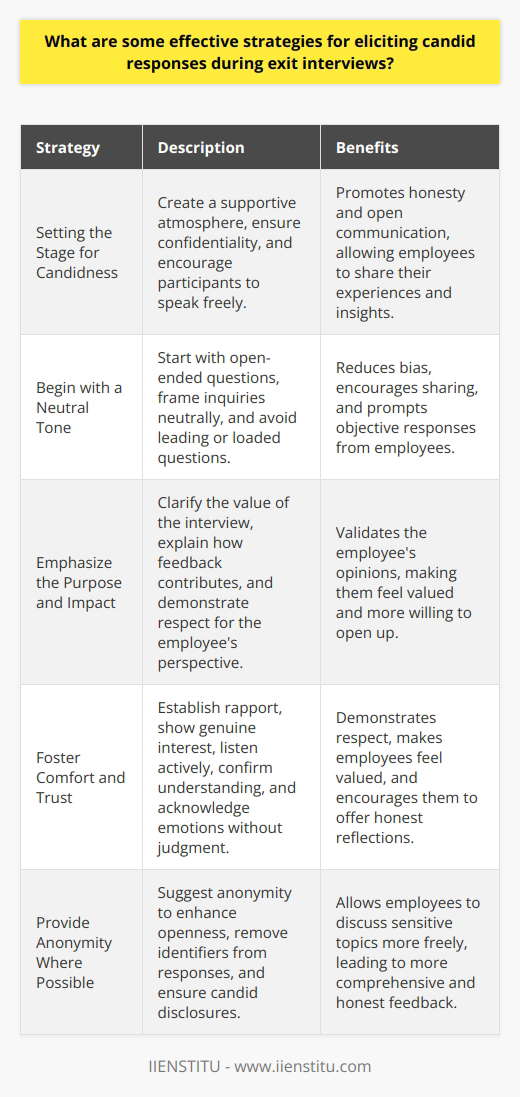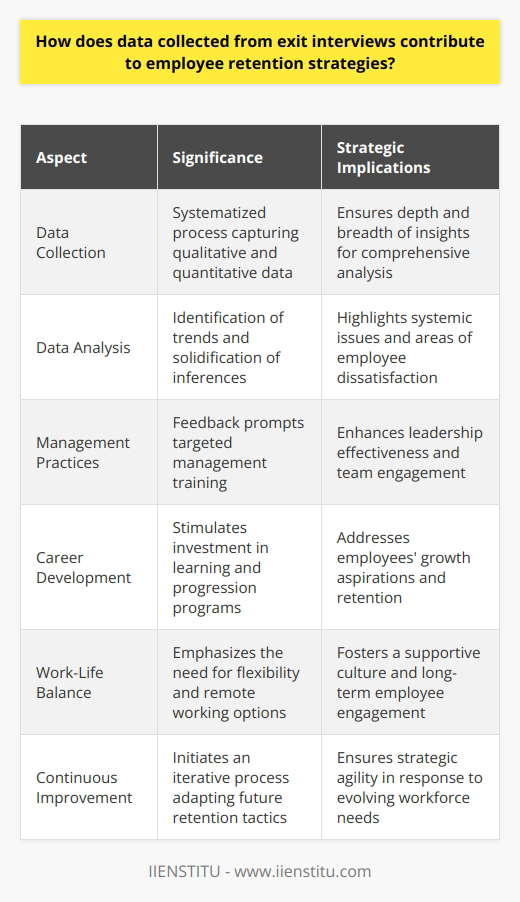
In the intricate tapestry of organizational management, the exit interview stands as a critical final thread woven into the employee lifecycle. This process, often overlooked, harbors the potential to illuminate the inner workings of an organization’s culture, practices, and employee morale.
As businesses continue to grapple with the intricacies of employee retention and organizational development, the value proposition of conducting thorough exit interviews becomes ever more apparent. In this article, we explore the exit interview process, its implications for talent retention, and the best practices to glean transformative insights from this organizational touchpoint.
Proactive Corporate Hr Strategy For İmproved Employee Engagement
Comprehensive Guide On Hr Policies And Procedures İmplementation Steps
Understanding the Exit Interview Process
Purpose and Objectives of Exit Interviews
For organizations, exit interviews serve as a diagnostic tool to identify latent issues within the workforce or operational structures. They can reveal patterns in employee dissatisfaction, potential gaps in HR policies, or hidden strengths that can be leveraged further. For the departing employee, the exit interview provides an opportunity to share feedback in a structured and potentially impactful way, allowing for closure on their tenure with the company.
For the organization, exit interviews can contribute to strategic HR management and workforce planning. By extracting honest feedback, companies can analyze trends and implement measures to improve the workplace environment. For the employee, it presents a chance to leave on a good note, possibly opening doors for future collaboration or reemployment.
Participants in an Exit Interview
Typically, the HR department will conduct exit interviews involving a representative and the exiting employee. In some cases, a direct supervisor may also participate, but this can depend on the dynamics of the departure and the purpose of the session. It is crucial that the interviewer is viewed as impartial and is skilled in eliciting candid responses from the interviewee.
Timing of an Exit Interview
Timing can be pivotal in extracting undistorted feedback. Exit interviews should ideally be scheduled close to the final working days of the employee to ensure that their experiences are fresh and top of mind. However, it’s important to provide enough notice to prepare both the employee and the interviewers to engage thoughtfully and constructively.
Format of an Exit Interview
The format of the exit interview can vary from one organization to another. Face-to-face interviews are generally preferred as they facilitate the building of rapport and enable the interviewer to gather nonverbal cues. Conversely, written questionnaires can be less confrontational and may lead to more honest feedback, while online surveys offer convenience and can still yield valuable data when crafted effectively.
Planning and Conducting an Effective Exit Interview
Tenets of an Effective Exit Interview
An exit interview transcends a mere formality and should be approached with careful consideration. At its core, an effective exit interview should elicit transparent, actionable insights. This requires thorough preparation, understanding of organizational psychology, and an authentic desire to learn and improve from the departing employee's experience.
Preparing for an Exit Interview
Setting the agenda sets the tone for a structured and focused exit interview. The interviewer should outline topics to cover, ensuring that the session moves beyond superficialities. Emphasizing confidentiality and voluntary participation also helps in securing the trust of the interviewee, which is essential for gaining sincere and constructive feedback.
Confidentiality is key in encouraging open dialogue, while voluntary participation reinforces the notion that the feedback is valued and not an obligation. This respect for the interviewee's autonomy facilitates a more fruitful exchange.
Conducting the Exit Interview
To conduct an exit interview effectively, the interviewer must create a safe space that encourages open dialogue. Employing active listening skills is essential and underscores the interviewer's genuine interest in the employee's perspective. Asking open-ended questions invites elaborative responses and discourages the simple 'yes' or 'no' format that might inhibit detailed feedback.
Building rapport is more than mere courtesy; it forms the foundation for a meaningful conversation. Similarly, active listening is not merely nodding along but understanding and probing deeper into the responses given. Open-ended questions serve to peel back layers, revealing insights that are often shrouded in hesitation or ambiguity.
Post-Exit Interview Actions
Recording and analyzing the data meticulously transforms the exit interview from a conversation into an actionable tool. Swiftly addressing feedback and taking appropriate action can lead to immediate improvements and demonstrate to current employees that their voices are heard and valued.
Documentation is vital in preserving the integrity of the feedback, allowing for trend analysis and archiving valuable historical data. Follow-through on the feedback is a critical component in closing the feedback loop and ensuring that the exit interview contributes to positive organizational change.
Common Pitfalls and how to Avoid them
Misinterpretation of data
One significant risk involved in exit interviews is the potential misinterpretation of data. Administrators must approach the findings with an analytical mind, seeking patterns and correlations, whilst being wary of individual biases. Data should be contextualized within the broader organizational culture and workforce dynamics.
Indifference or lack of follow up on feedback
An apathetic approach to the feedback gathered during exit interviews can nullify the process's value. It is crucial that the information gathered is acted upon, or at least acknowledged, to foster a culture of continuous improvement within the organization.
Biased or leading questions
Maintaining neutrality is essential in an exit interview. Biased or leading questions can skew the data, leading to unreliable insights that may misdirect rather than guide organizational development. Questions should be designed to evoke the employee's true experience, free from the influence of the interviewer's preconceptions.
Lack of confidentiality
Perceived breaches in confidentiality can deter candidness and defeat the very purpose of an exit interview. Upholding the promise of discretion not only in the session but in the treatment of the information post-interview is essential to preserving trust and integrity within and beyond the HR process.
The Impact of Exit Interviews on Organizational Development
Unveiling areas for improvement
Exit interviews are a vital source of information, unveiling areas that demand improvement within the company. They enable leaders to address issues before they escalate, making alterations that could prevent further departures of valuable talent.
Employee Retention strategies
Utilizing the insights from exit interviews can inform and refine hr certification programs and online courses. These educational initiatives can be tuned to address the professional development areas highlighted by exiting employees, enhancing both recruitment and retention strategies.
Creating a healthier organizational culture
In addition to addressing structural or policy-driven concerns, exit interviews can shed light on the more imperceptible aspects of organizational culture that might influence employee satisfaction and turnover.
Increasing employee engagement and productivity
The ripple effects of acting on exit interview data can boost morale, engagement, and productivity by signaling to employees that their employer values their feedback and is willing to invest in improvements.
Exit interviews, conducted with intention and integrity, can transform an often-overlooked HR task into a treasure trove of insights.
These discussions, punctuated by authentically inquisitive and respectful exchanges, hold the mirror up to the organization's collective practices, highlighting strengths to celebrate and challenges to surmount.
As we've delineated, preparations for an exit interview, the considerations during the interview, and the actions following it, all contribute to amplifying its efficacy.
In conclusion, the ultimate value of exit interviews lies in their ability to fuel a transparent, collaborative, and productive work environment. When executed thoughtfully, exit interviews not only honor the contributions of departing employees but serve as a litmus test for the organization's commitment to evolution and excellence.
Frequently Asked Questions
What are some effective strategies for eliciting candid responses during exit interviews?
Setting the Stage for Candidness
Exit interviews hold critical insights. They reveal why employees depart. Organizations gain improvement insights. For honesty, a supportive atmosphere is essential. Interviewers should ensure confidentiality. It helps participants speak freely.
Start with a Neutral Tone
Begin with open-ended questions. This encourages sharing. Frame questions neutrally. Avoid leading or loaded inquiries. Neutral phrasing reduces bias. It prompts objective responses.
Emphasize the Purpose and Impact
Clarify the interview's value. Explain how feedback contributes. This demonstrates respect. It validates the employee's perspective. Individuals feel their opinions matter. They become more willing to open up.
Foster Comfort and Trust
Establish rapport early. Show genuine interest. Listen actively. Confirm understanding through rephrasing. Acknowledge emotions without judgement. Avoid interruptions. This demonstrates respect. Employees feel valued. They tend to offer honest reflections.
Provide Anonymity Where Possible
Suggest anonymity to enhance openness. Remove identifiers from responses. This ensures candid disclosures. Many prefer anonymity when discussing sensitive topics.
Encourage Both Positive and Negative Feedback
Request balanced feedback. This avoids a negative focus. Employees should share achievements and frustrations. This comprehensive view aids organizational learning.
Follow Up for Clarification
Ask clarifying questions. This probes deeper into issues. It yields richer insights. Gentle probing uncovers underlying problems. Do not press. Allow silence if needed.
Exit interviews offer organizational growth opportunities. Honesty during these meetings is crucial. Open, supportive environments elicit frankness. Trust, neutrality, and clarity prove instrumental. Through these techniques, organizations learn and evolve.

How does data collected from exit interviews contribute to employee retention strategies?
Understanding Exit Interviews
Exit interviews hold a mirror to organizational culture. They uncover truths often unnoticed. Employees part with valuable feedback candidly. This feedback is a goldmine for improvement.
Collecting Exit Data
Organizations systemize exit interview processes. They capture qualitative and quantitative data. Diversity in questions ensures depth.
Analyzing Employee Feedback
Analysis follows data collection. Trends emerge from qualitative assessments. Quantitative data solidifies inferences.
Informing Retention Strategies
Data directs action plans. It highlights systemic issues. Employee dissatisfaction areas become evident.
Strategic Implementation
Employee retention strategies evolve from this data. They target specific pain points. Custom retention plans materialize.
Areas of Focus
Data may indicate poor management practices. It often reveals gaps in career development opportunities. Employees might flag work-life balance issues.
Streamlining Management
Feedback can prompt management training. Leaders learn to engage teams better. Effective leadership brings tangible improvements.
Enhancing Career Development
Employees seek growth opportunities. Exit data can stimulate career programs. Companies invest in learning and progression.
Promoting Work-Life Balance
Work-life balance is critical. Data highlights the need for flexibility. Organizations introduce remote working options.
Improving Recognition Schemes
Exit interviews may point to undervalued staff. Recognition schemes become a priority. They foster a culture of appreciation.
Compensation Adjustments
Competitive pay is paramount. Exit data often demands pay scale adjustments. Pay realignments retain existing talent.
Fostering Organizational Culture
Exit interview insights drive cultural initiatives. A supportive culture is critical. It ensures long-term employee engagement.
Continuous Improvement
Exit interviews initiate an iterative process. Findings inform immediate strategies. They also adapt future retention tactics.
Follow-Up Action
Data implementation is crucial. Employee feedback requires a response. Action demonstrates commitment to change.
Closing the Loop
Organizations must circle back to employees. Staff surveys assess the effectiveness of changes. Continuous dialogue maintains morale.
Exit interviews are a strategic tool. They lay out a blueprint for retention. Data turns departing employees' insights into a retention roadmap.

What kinds of follow-up actions should organizations consider based on the insights gathered from exit interviews?
Organizations often rely on exit interviews. They gather critical feedback from departing employees. This feedback can reveal important insights. The insights help to improve the workplace. To capitalize on this feedback, companies need a strategy. Follow-up actions are crucial. They address issues and enhance retention. Implementing them effectively fosters continuous improvement.
Identifying Trends and Patterns
Firstly, analyze exit interview data systematically. Look for common themes. Frequency indicates a widespread problem. Pinpoint unsettled departments or positions. Quantitative data supports qualitative feedback. Organize findings into categories. Examples include management, work environment, and compensation.
Communicating Findings
Transparency builds trust within an organization. Share summarized findings with the management team. Avoid disclosing personal information. Highlight opportunities for improvement. Seek buy-in for changes from leadership.
Prioritizing Issues
Not all feedback requires immediate action. Prioritize issues based on impact and feasibility. Address critical and easy-to-fix problems first. Plan for long-term changes for complex issues.
Implementing Solutions
Create action plans for identified issues. Detail steps, responsible parties, and timelines. Short-term fixes might include policy changes or training. Long-term solutions require more planning. They might involve company culture changes or restructuring.
Reviewing Policies and Practices
Review your existing policies. Ensure they align with employees' expectations. Update them to prevent future grievances. This may involve enhancing communication channels. It could also include revising compensation structures.
Fostering a Positive Culture
A positive work environment increases retention. Address concerns raised about the work culture. Initiate programs that promote employee well-being. Examples include recognition programs and career development opportunities.
Engaging Current Employees
Involve employees in solution development. Gather their input and ideas. This increases engagement and compliance with new initiatives. It also demonstrates a commitment to their satisfaction.
Monitoring Progress
Establish metrics to monitor changes. Examples include turnover rates and employee satisfaction scores. Tracking progress ensures that actions are effective. It also allows for course correction if necessary.
Adjusting Strategies
Be flexible with follow-up actions. Adapt them based on ongoing feedback and performance. Continuous improvement requires willingness to change.
Follow-up actions are vital after exit interviews. They turn feedback into positive change. This approach emphasizes a proactive organizational culture. Organizations must analyze, act, and adapt. Through this, they foster improved job satisfaction and retention.

